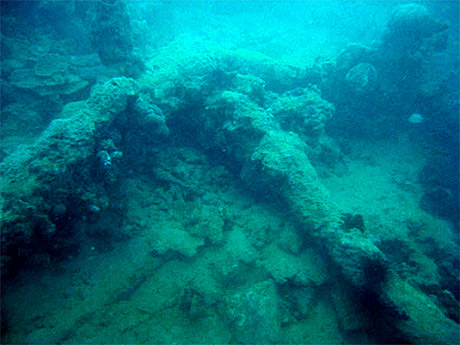
Overall Site Impression
27 November 2008
By Michael Tuttle
The site that we have been archaeologically investigating during the present field effort may have great historic significance relative to the American Revolution. The Serapis was the prize of the most fierce ship to ship naval battle conducted during the war for American independence. Presented to France as a prize, due to the loss of the Bonhommie Richard, the vessel was sent to the Indian Ocean in the Service of its new Owners. Unfortunately, for its owners the ship did not complete its assigned mission. Fortunately for archaeologists and historians the trail of the vessel stopped off Isle Ste. Marie, Madagascar.
The shipwreck remains and associated cultural material that have been the focus of our current research project present the very exciting possibility that they are associated with the remains of the Serapis. The historic record indicates that the Serapis was lost in the in the Harbor off Isle Ste. Marie. Additionally, the dimensions of the Serapis, a 44-gun frigate, are known from historic sources and can be compared to the physical remains recorded beneath the harbor.

18th century admiralty anchor found on site.
Another indicator on the vessel is the copper bottom sheathing on the site. The copper was a technological innovation that can be accurately dated and is known to be a feature of the Serapis. Historic research to date has not indicated any other vessel of the type, size and copper bottom sheathing that was lost in the harbor at Saint Marie. Analysis of artifacts found on the site, and some samples of materials will also aid in setting a date range for the assemblage found in association with the site.
A ship's bell with the name Serapis or other artifactual evidence has not been found to 100% indicate the identity of the vessel remains. However the meticulous archaeological recordation of the site, and analysis of the cultural remains are now being conducted in order to create a temporal context for the site under investigation. There are many indicators that the remains do indeed represent a late eighteenth century shipwreck site. Additionally, some of the technological innovations, copper bottom sheathing, were rare on merchant ships but not on ships-of war are positive indicators of the identity of the vessel remains. At present it is too early to definitively conclude that the remains are the Serapis. However, further research and analysis of the the materials and samples observed may well lead to that end.
Please feel free to contact us at mua@keimaps.com with any comments, questions, or suggestions during the weeks to come.
Return to Project Journal home page.


